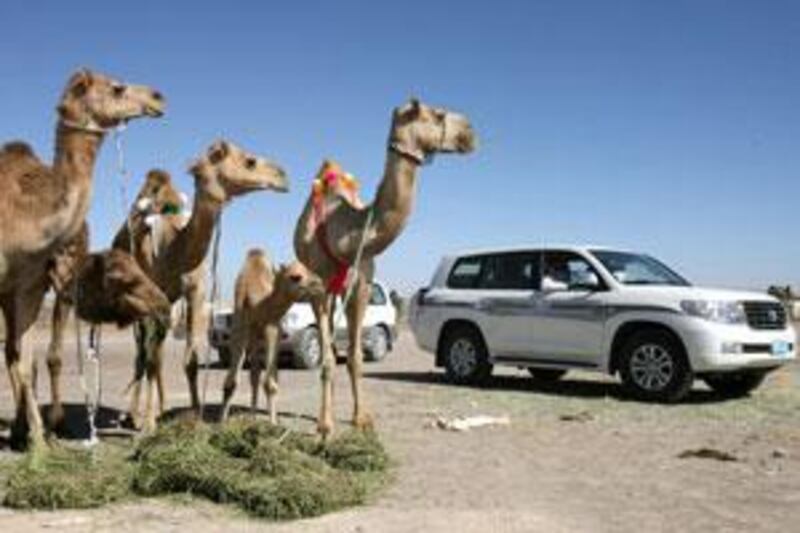Cars are replacing camels in the verses of Bedouin poets. It's nine o'clock at night and the crowd at the giant Moreeb Dune is enveloped in billowing clouds of barbecue smoke. Clusters of Emirati spectators huddle around fires for warmth, and tables of shisha smokers stare up at the giant mound of sand, when suddenly the dull hum of conversation is rent by the hysterical vroom of an engine as a 4x4 the size of a small bus roars, struggles and fishtails up the 300m-tall dune.
Across the Arabian Penninsula, events like this one - the Moreeb Dune Cars and Motorbikes Championship, part of the recent Liwa International Festival - have firmly established themselves alongside the more traditional Bedouin pursuits of camel and horse racing. Moreover, such festivals aren't the only cultural institutions where hoofs and headlights exist side by side. Motorised vehicles have long since taken over the functional role once played by horses and camels in Bedouin life. But as the years go by, scholars say, cars are also taking on something similar to the animals' cultural significance - particularly in Bedouin poetry.
"In the Bedu worldview, the ability to get from A to B is an important thing," says Sam Liebhaber, an assistant professor of Arabic and international studies at Middlebury College in the US. "Any means that facilitates that movement is welcome." Liebhaber is one of a handful of scholars who have studied mentions of vehicles in Bedouin poetry. They've found that, in metaphor as in transport, cars are the new camels.
In traditional Nabati (or Bedouin) verse, horses, camels and falcons often function as "messengers" - delivering wedding invitations, love notes or challenges from an adversary, says Clive Holes, a scholar of contemporary Arabic literature and linguistics at Oxford. And in some recent Bedouin poetry, he says, cars have come to play a remarkably similar role. Vehicles that serve as such poetic "messengers" are even described in ways that mirror traditional descriptions of animals.
"With the camel there are any number of typical kinds of things you can comment on, such as the camel's speed, thick tail hair, its nature, pedigree and various anatomical details," says Holes, who spoke earlier this year on Nabati poetry at the Abu Dhabi Cultural Foundation. "They transpose the type of anatomical detail on the camel to describe a car. They talk about the chassis being really strong, which is a bit like the bone structure, or how the leather seats are of particularly fine quality, while with a camel we'd talk about its skin. It's a question of the transposition. It's pretty common in Saudi poetry," Holes explains over the phone from London.
For other poets, cars and trucks have become a subject in their own right; some poems discuss the modern-day annoyances of radar guns, or the hardship of having your car stuck at the garage until you can find enough cash to pay the mechanic. Liebhaber, who specialises in the language and poetry of the Mahra in south-east Yemen, quotes from one particular poem that describes a vehicle using the metaphor of a milk camel. In the poem, by the Mahra poet Isa Kedheyt, a man is constantly giving people rides in his car but then must ask his passengers to pony up cash to help pay for the vehicle:
In my lockbox there's not even any pocket-change; We have already massaged the udder of the milch-camel, may God increase Anss! [the name of a milch-camel] But then she refused and lifted up her head, She didn't even give suck to her child. "He is tying a traditional motif of a cow, which implies milk and abundance, with a car that brings sustenance or livelihood," says Liebhaber. Such marriages of natural and mechanical, old and new, have energised Bedouin poetry, Liebhaber says. While in other parts of the world tradition and modernity square off head to head, he thinks modernity has helped colloquial poetry flourish in several ways. "Poetry accrued this aura of being an important cultural aspect that Bedouin Arabs have held onto in the race to modernity - and recording technology actually makes it easy for these poems to be transmitted," he says. "The genre is strong and vibrant enough to accept the contemporary material culture and insert it into contemporary cultural practices."
In other words, you might say that colloquial Bedouin poetry, backed by an eight-cylinder engine, centrifugal supercharger and Michelin Rally tyres, has a plenty of miles left on it.





